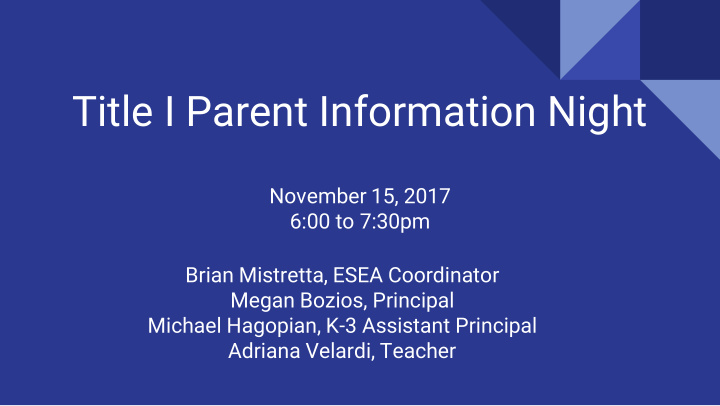



Title I Parent Information Night November 15, 2017 6:00 to 7:30pm Brian Mistretta, ESEA Coordinator Megan Bozios, Principal Michael Hagopian, K-3 Assistant Principal Adriana Velardi, Teacher
Agenda ● Overview of Title I ● Eligibility of students ● Receive parent feedback on required documents a. Family Engagement Policy 6171.3: a. School Parental Involvement Policy a. School-Parent Compact
ESEA replaces NCLB The Every Student Succeeds Act (ESSA), a reauthorization of the Elementary and Secondary Education Act (ESEA), was signed into law on December 10, 2015. This law helps ensure educational opportunity for all students by: 1. Holding all students to high academic standards that prepare them for success in college and careers. 2. Ensuring accountability by guaranteeing that when students fall behind, states redirect resources into what works to help them and their schools improve, with a particular focus on the very lowest-performing schools, high schools with high dropout rates, and schools with achievement gaps. 3. Empowering state and local decision-makers to develop their own strong systems for school improvement based upon evidence, rather than imposing cookie-cutter federal solutions like the No Child Left Behind Act did. 4. Reducing the often onerous burden of testing on students and teachers, making sure that tests don't crowd out teaching and learning, without sacrificing clear, annual information parents and educators need to make sure our children are learning. 5. Providing more children access to high-quality preschool. 6. Establishing new resources for proven strategies that will spur reform and drive opportunity and better outcomes for America's students.
Title I Allowable Uses To help local educational agencies (LEAs) improve teaching and learning in high-poverty schools in particular for children failing, or most at-risk of failing, to meet challenging State academic achievement standards. 1) Ensuring that high-quality academic assessments, accountability systems, teacher preparation and training, curriculum, and instructional methods are aligned with challenging state academic standards so that students, teachers, parents and administrators can measure progress against common expectations for student academic achievement; 2) Meeting the educational needs of low-achieving children in our Nation's highest-poverty schools, including English language learners, migratory children, children with disabilities, and homeless children. 3) Closing the achievement gap between high- and low-performing children, especially the achievement gaps between minority and non- minority students, and between disadvantaged children and their more advantaged peers; 4) Distributing and targeting resources sufficiently to make a difference to local educational agencies and schools where needs are greatest; 5) Improving and strengthening accountability, teaching and learning by using state assessment systems designed to ensure that students are meeting challenging state academic achievement and content standards and achievement overall, but especially for the disadvantaged. 6) Providing greater decision making authority and flexibility to schools and teachers in exchange for greater responsibility for student performance; 7) Providing children an enriched and accelerated educational program, including the use of schoolwide programs or additional services that increase the amount and quality of instructional time. 8) Promoting schoolwide reform and ensuring the access of children to effective, scientifically-based instructional strategies and challenging academic content. 9) Significantly elevating the quality of instruction by providing staff in participating schools with substantial opportunities for professional development to address the needs of low-performing students. 10) Coordinating services under all parts of this title with each other, with other education services, and, to the extent feasible, with other agencies providing services to youth, children and families; and 11) Affording families meaningful opportunities to participate in the education of their children.
Title I Programming for 16-17 ● Parent meeting held Wednesday May 10, 2017 at 8:00am in Room 151 “Building a Foundation of Literacy Success” ● ○ Program ran Thursday May 4, 2017 to Monday June 19, 2017 Before school from 7:55 a.m. to 8:25 a.m. ○ Kindergarten instructors ● Mrs. Malwitz and Ms. Dell’Olio ○ 1st grade instructors ● ○ Mrs. Terzano and Ms. Guinan 2nd grade instructors ● ○ Ms. DeLucia and Ms. Telfer
Student Eligibility Criteria for 16-17 Kindergarten 2nd Grade 1st Grade Level A or B on TC TC score of an A or Level K or below, B, as well as some directed writing assessment, students reading on a sample, sight word weaknesses in letter- level C. Sight word recognition and/or sound and sight word recognition and teacher recognition, and/or encoding skills were recommendation teacher also utilized recommendation
Student Eligibility Criteria for 17-18 Kindergarten 2nd Grade 1st Grade Uppercase letters, Previous and current Previous and current year TC year TC uppercase sounds, assessments, sight assessments, sight uppercase letters, word recognition, words and words rhyming lists encoding skills their way, fall 2017 LinkIt! score in ELA
Title I Programming for 17-18 ● Before school program focusing on specific areas of weakness for selected students based on multiple measures taken at the start of the school year 3 to 4 days per week, 7:55 a.m. to 8:25 a.m. ● 2 classes per grade, approximately 6 students per class ● Targeted direct and small group instruction ● Depending on success of program and growth of students, potentially start ● new group of students in each grade after 6-8 weeks ● OR, keep same students in before school program to work on other areas in need of remediation Plan to start in early December 2017 ●
Title I Parent and Family Engagement “To be completed by the LEA/school within four weeks of the beginning of the school year.” District Level Parent and Family Engagement Policy (6171.3) ● ○ https://goo.gl/neMvyd School Level Family and Family Involvement Policy ● ○ https://goo.gl/pbpdmj School Parent Compact ● ○ https://goo.gl/fy1557 ● Title I Annual Meeting Invitation (informing parents of student eligibility) English Language Learners letter ● ● Title 1 Right to Know Letter September 2017 (pdf)
Considerations For Future Planning? ● Next year, utilize a Math component along with ELA? To avoid confusion with student eligibility, wait until December conferences ● to discuss eligible students and start program in January? Add additional grades? ● Family Nights (Math)? ●
Title I Resources http://oradellschool.org/osnj/OUR%20SCHOOL/Title%201/ http://www.nj.gov/education/title1/
Recommend
More recommend